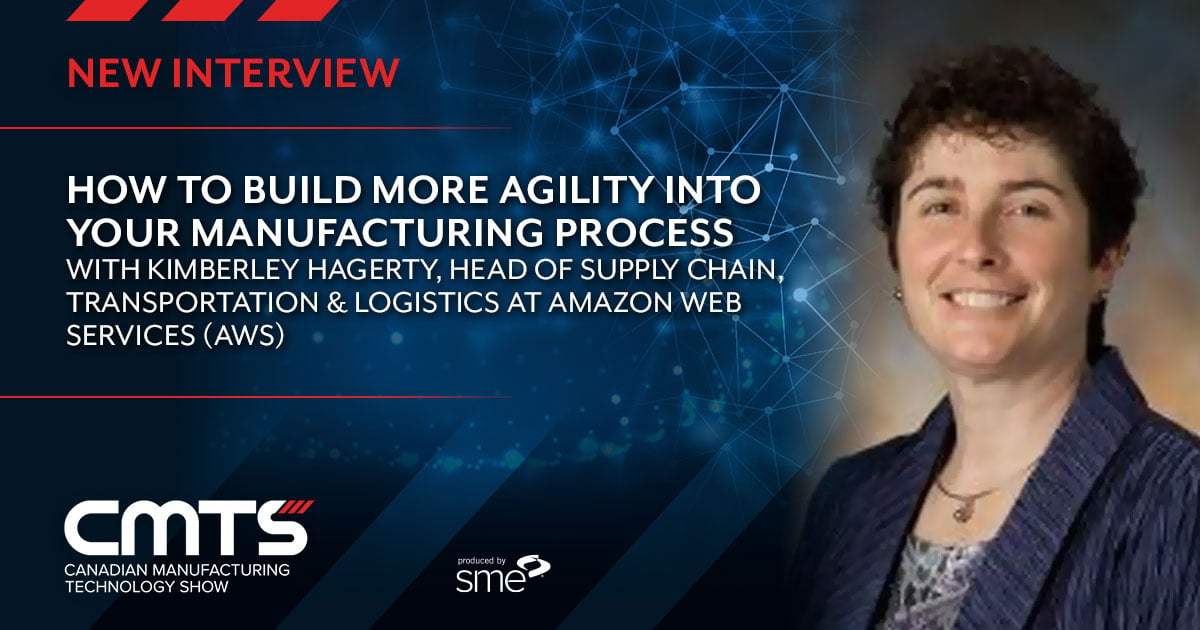
Agile manufacturers are able to build more resilient supply chains and improve their long-term financial success. Learn more at CMTS 2021.
Without an agile supply chain, manufacturers will struggle to recover from disruptions, reduce business and increase customer risk. Supply chain resiliency is a crucial, non-negotiable trait of every resilient manufacturing operation.
At the Canadian Manufacturing Technology Show (CMTS) in October, a keynote panel will explore how agility can improve supply chain resiliency, create competitive advantages and boost long-term financial success.
We spoke with Kimberley Hagerty, moderator of this year’s keynote panel and head of Supply Chain, Transportation & Logistics at Amazon Web Services (AWS), for a preview.
Q: You started your career in the U.S. military. How has this experience helped you in the private sector?
Three words come to mind: Speed, adaptability and agility.
Those three words are really the difference between mission success and failure, and that nicely translates to supply chain resiliency.
Q: Can you give us an example?
In the military, I was able to work with some of the most advanced technologies in the world.
Having the right tools for the job was definitely mission-critical, and we were always looking to innovate and get the right technology to reduce risk and ensure mission success.
And that's really what we do here at AWS. Innovation is in our DNA.
We are customer-obsessed, so naturally we want to provide our customers with not only the right tools, but the most innovative, world-class tools, to help them with their digital transformation journey.
Q: What practical steps can small and medium-sized manufacturers take to become more agile?
You really need to shift your mindset to be more data-driven.
Data now is more of a corporate asset than the physical system itself, so you need to have a data strategy that's integrated into your manufacturing strategy.
It's not enough to have machines or devices or sensors or robots. You really need to have a data strategy around the operational intelligence aspect -- how to set up your end to end value network and why?
What data will it provide? How will I use it, and how will that data help reduce risk to my operations, to my production environment, to my financial bottom line, and to my customer?
Q: What does a resilient supply chain look like to you?
Supply chain resiliency is the ability to quickly recover, and reduce business or customer risk from supply chain disruptions.
So, what capabilities does a resilient supply chain have?
It's visibility -- the ability to track, to monitor and to predict. It's flexibility -- the ability to adapt and respond quickly, minimizing impact to the customers and to the business.
It's collaboration -- it's end-to-end connectivity, and optimizing and collaborating across all enterprise stakeholders. And then it's really about controlling, with robust policies and control mechanisms around people, process and technology.
Q: How can smart digital technologies help when it comes to supply chain resiliency?
At the end of the day, it's really all about data connectivity, and the ability to ingest data, to consume data, to transform data, harmonize data and categorize it in order to make the data from all these different disparate silos systems, usable.
Once you get past that hurdle, you now have data that you can see, that you can run in real time, and you can get it to provide actionable insight in order to be predictive and prescriptive in your decision making.
Q: What prompted you to attend CMTS this year?
Getting industry experts together in one place really is the only way for companies to stay current on what's going on around the industry.
Technology has never moved as fast as it is today, and it will never move this slow again.
So getting to talk with, to see, to touch, to feel what's going on, to see what technologies are out there and what companies are actually doing with those technologies to transform their business, is really necessary to keep pace.
What you take away from events like CMTS can change the direction of whatever business goals or objectives you have, and make them more relevant and achievable.
Also, it’s lessons learned. You want to avoid false starts at all costs when you're going through digital transformation. This is a great way to avoid common pitfalls that others have experienced.
Q: Why should people attend this panel?
Everyone has some aspect of a digital transformation strategy. The hardest part of the journey is not knowing what it looks like, and what it will produce. It's like jumping into a lake when you don't know how deep the water is.
You want to remove as much uncertainty as possible. We want to be able to provide personal insight into the what, the how and the why, for as many people as we can.
Q: Is there anything else you'd like to say?
I am really excited to be able to play a leading role in getting the industry back together after a year of lockdown, and I'm even more excited to be able to connect with everyone who's going to attend.
This is just what we all need. We all need to get back out there and start making a difference.
Join us at the Canadian Manufacturing Technology Show in Toronto, October 4-7 at the International Centre in Toronto. Or join us virtually from anywhere in the world.
Registration is free for a limited time. You’ll get hands-on experience with the latest technology, and the information you need to supercharge your business.
